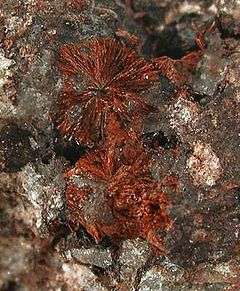Xocolatlite
| Xocolatlite | |
|---|---|
|
Moctezuma Mine, Moctezuma, Municipio de Moctezuma, Sonora, Mexico | |
| General | |
| Category | Sulfate minerals |
| Formula (repeating unit) | Ca2Mn4+2(Te6+O6)2 · H2O |
| Strunz classification | 7.DF.85 |
| Crystal system | Monoclinic |
| Crystal class |
Prismatic (2/m) (same H-M symbol) |
| Space group | P2/m |
| Identification | |
| Formula mass | 655.24 g/mol |
| Color | Chocolate brown |
| Crystal habit | Encrustations; Micaceous |
| Fracture | Conchoidal |
| Mohs scale hardness | 2-3 |
| Luster | Vitreous |
| Streak | Copper brown |
| Diaphaneity | Transparent |
| Specific gravity | 4.10 g/cc |
| Density | 4.1 g/cc |
| References | [1][2] |
Xocolatlite is a sulfate mineral named for its chocolatey appearance. Discovered in the La Bambolla gold mine of Moctezuma, Sonora, Mexico, Xocolatlite's name is derived from the Nahuatl word xocolatl (literally "bitter water"; a root word of "chocolate"), a drink made from cocoa, water, and chili.
References
This article is issued from Wikipedia - version of the 12/4/2016. The text is available under the Creative Commons Attribution/Share Alike but additional terms may apply for the media files.
